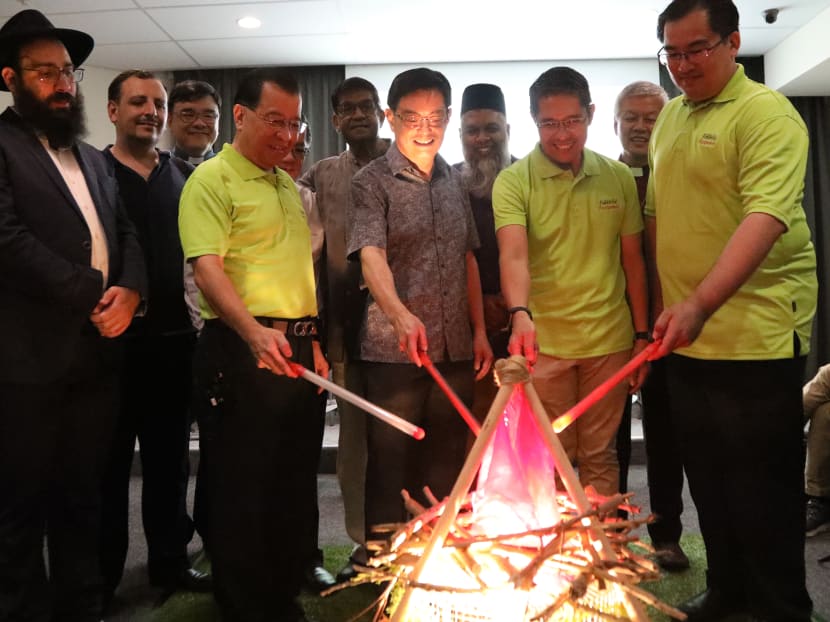‘Blessed’ by prayers from many faiths after 2016 stroke, DPM Heng stresses value of religious harmony
SINGAPORE — After a sudden stroke forced him out of action temporarily in 2016, Mr Heng Swee Keat, then Finance Minister, was approached by leaders of various faiths who told him they had prayed for him.

Deputy Prime Minister Heng Swee Keat (first row, third from right) lighting a “fire” before a fireside chat at The Harmony in Diversity Gallery.
SINGAPORE — After a sudden stroke forced him out of action temporarily in 2016, Mr Heng Swee Keat, then Finance Minister, was approached by leaders of various faiths who told him they had prayed for him.
“I felt very blessed,” Mr Heng said on Monday (Aug 12) at a fireside chat in the Ministry of National Development (MND) Building on Maxwell Road.
“We must be deeply committed to preserving this racial and religious harmony.”
Speaking to 68 people from the South East district of Singapore, Mr Heng, who is now also Deputy Prime Minister, drew repeatedly on his own experiences with people of different faiths as he made the point that Singapore’s religious harmony and diversity are strengths that need to be preserved.
The audience had earlier taken part in a new interfaith heritage programme, which included visits to various places of worship in the historic Kampong Bencoolen area.
In May 2016, Mr Heng suffered a stroke during a Cabinet meeting, but recovered and returned to work several months later.
He said that during an interfaith harmony event that he attended with Prime Minister Lee Hsien Loong after his return, many members of various faiths told him they had prayed for him.
“Every religious leader said that to me… Whether it is the highest standard of medical care or the highest standard of religious harmony, where everyone said they prayed for me, I felt so blessed to be in Singapore,” he said.
TURNING SIZE, DIVERSITY INTO ASSETS
Singapore may be small, Mr Heng said, but its size and diversity could be turned into assets that would reap economic benefits.
For example, he said, back when he was helming the Monetary Authority of Singapore (MAS), Islamic finance was a subject of growing interest.
To find out more, Mr Heng, who was MAS managing director from 2005 to 2011, visited key Middle Eastern countries, including Bahrain, Qatar and the United Arab Emirates. On these trips, Muslim officers from the MAS taught him the dos and don’ts, as well as Middle East traditions.
“It was most helpful and as a result… I was able to establish fairly good rapport with central-bank governors in many of these countries,” he said.
To turn the country’s diversity into an asset, Singaporeans must be able to interact with people around the world, he added, as the Republic must be linked to all the key economic centres globally.
He likened such a relationship to a “string of pearls of vibrancy” across the world.
“It will give us tremendous value, and create enormous value for people around the world as well as for ourselves,” he said.
Singapore, he said, has a “great source of advantage” in that its ancestors came from around the world, and its diverse society is made up of everyone from new and old citizens to permanent residents.
The country should think hard about how to push the envelope in turning that diversity into a great strength, the deputy prime minister added.
DIVERSITY IS KEY
Mr Heng, 57, said that he grew up in a kampung, or village, of Chinese people in the 1960s, when Singapore was dogged by racial riots. Next to his village was a Malay kampung.
When his family travelled into town, they had to pass through a narrow road that led to the bus stop. “Everyone was so scared that I was not allowed to walk there on my own. Every time we needed to go downtown, we had to be escorted in a big group and it was terrifying,” he recalled.
But in secondary school, Mr Heng’s regular companion on walks home was a Malay boy in the same level he was.
“It’s quite amazing how we have grown over the years and how we take racial and religious diversity and harmony very seriously,” he added.
During Monday’s fireside chat, which lasted about an hour, participants were invited to reflect and talk about their experiences of the heritage trail they had taken that morning. Mr Heng was then asked to respond with his thoughts on their experiences.
Asked by an audience member how Singapore could move beyond the contributions of individuals to emphasise the part played by the community, Mr Heng said it was important to acknowledge both.
Stories of individuals show how people from various parts of the world with different backgrounds and talents have made significant contributions to Singapore society, he said.
But the work of the community counts, too. For example, Singapore has various bodies, from clans to religious groups, that encourage people to gather and look after one another to benefit the community, said Mr Heng.
“It’s very important for us not to think… just as an individual, but how we as a community can do (our part),” he added.
INTERFAITH TRAIL
The Faithful Footprints interfaith heritage programme, which Mr Heng launched on Monday, includes a 1.7km guided trail to eight places of worship in Kampong Bencoolen.
These include the Kwan Im Thong Hood Cho Temple and Maghain Aboth Synagogue on Waterloo Street, Masjid Bencoolen mosque on Bencoolen Street, and the St Andrew’s Cathedral on St Andrew’s Road.
Social worker Yogeswari Chandrasekaran, 33, said that she did not know the difference between a cathedral and church before the trail, and was intrigued by the Jewish synagogue, which she had never visited.
The chairperson of the Siglap Indian activity executive committee said that she would draw on the lessons she learnt during the trail in her conversations with residents about multiculturalism.
Madam Ann Cheng, 64, a fellow participant and Siglap grassroots leader, also found the programme useful. “Next time if there are conflicts, I can help to tell them this is a harmonious society, and we all want to integrate and help one another regardless of race and religion,” said the retired personal assistant.
The half-day programme also covers a visit to the Harmony in Diversity Gallery in the MND Building, launched in 2016 to promote an appreciation of Singapore’s religious diversity. It ends with a fireside chat at the gallery where participants discuss past, present and future challenges to Singapore’s diversity and cohesion, and the importance of racial and religious harmony.
Twenty-five sessions, each with 30 to 40 participants, are scheduled for the next year. They will be held every two or three weeks, with the next one in September. The public may register for it at footprints [at] humanitymatters.org.sg.
The programme is a partnership between Temasek Foundation, the philanthropic arm of state investor Temasek Holdings, and Humanity Matters, a non-governmental organisation. It is supported by the South East Community Development Council.








